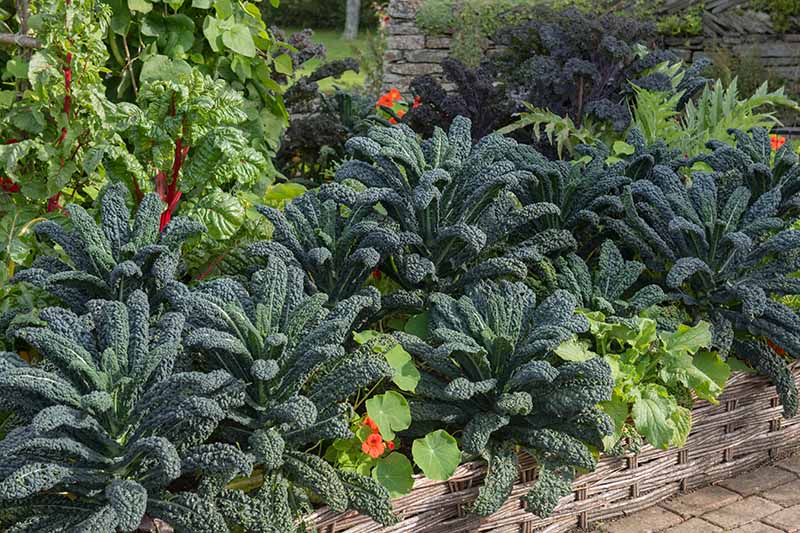Kale's Best Friends: The Ultimate Guide To Companion Planting
Kale is a versatile and delicious vegetable that can be enjoyed in a variety of ways. It's also a relatively easy plant to grow, but there are a few things you can do to help it thrive. One of those things is companion planting.
Companion planting is the practice of planting certain plants together for their mutual benefit. Some plants attract beneficial insects, while others help to deter pests. Some plants can even improve the soil quality or provide shade for their neighbors.
When it comes to kale, there are a number of plants that make great companion plants. Here are a few of the best:
- Alliums: Alliums, such as garlic, onions, and chives, have a strong scent that can repel pests like cabbage loopers and aphids. They can also help to improve the soil quality.
- Beans: Beans are nitrogen-fixing plants, which means they can add nitrogen to the soil. This can benefit kale, which is a heavy feeder.
- Carrots: Carrots and kale can help each other out by deterring pests. Carrots' strong smell can help to repel carrot flies, while kale's leaves can provide shade for carrots' roots.
- Cucumbers: Cucumbers and kale can help each other out by providing shade and support. Cucumbers' leaves can provide shade for kale's leaves, while kale's taller stature can provide support for cucumbers' vining growth.
- Herbs: Many herbs, such as dill, mint, and rosemary, can help to deter pests and attract beneficial insects. They can also add flavor to your kale dishes.
- Marigolds: Marigolds are another great companion plant for kale. They have a strong scent that can repel pests, and they can also help to attract beneficial insects.
- Potatoes: Potatoes and kale can help each other out by deterring pests. Potatoes' foliage can help to repel aphids, while kale's leaves can provide shade for potatoes' roots.
- Spinach: Spinach and kale can help each other out by providing shade and support. Spinach's leaves can provide shade for kale's leaves, while kale's taller stature can provide support for spinach's vining growth.
Of course, not all plants are compatible with kale. Some plants, such as broccoli, Brussels sprouts, and cauliflower, are all members of the brassica family. Planting these plants together can make it easier for pests to jump from one plant to the next.
If you're not sure which plants to plant with kale, it's always a good idea to do some research. There are a number of resources available online and in gardening books that can help you to choose the right companion plants for your garden.
Kale is a versatile and delicious vegetable that can be grown in a variety of climates. It's also a great candidate for companion planting, which is the practice of planting different types of plants together to benefit each other.
Some of the best companion plants for kale include:
- Alliums (such as garlic, onions, and chives): These plants help to repel pests that can damage kale, such as cabbage moths and aphids.
- Beans (such as bush beans and pole beans): Beans fix nitrogen in the soil, which can help to improve the growth of kale.
- Cucumbers: Cucumbers can grow underneath taller kale plants, providing them with shade and support.
- Marigolds: Marigolds help to repel pests and attract beneficial insects that can pollinate kale flowers.
- Radishes: Radishes are fast-growing and can be planted in between kale plants to help suppress weeds.
For more information about companion planting with kale, please visit Garden Wiki. This website has a comprehensive list of companion plants for kale, as well as tips on how to plant and care for these plants.
FAQ of companion planting with kale
- What are good companion plants for kale?
Kale can be planted with a variety of vegetables, herbs, and flowers. Some of the best companions for kale include:
* Artichokes. Artichokes help to repel pests such as cabbage moths and aphids.
* Beetroot. Beetroot helps to improve the soil quality for kale.
* Celery. Celery helps to repel pests such as carrot flies and root maggots.
* Cucumbers. Cucumbers help to attract beneficial insects such as ladybugs and hoverflies, which can help to control pests.
* Lettuce. Lettuce helps to suppress weeds and improve the soil quality for kale.
* Onions. Onions help to repel pests such as cabbage moths and aphids.
* Peas. Peas are nitrogen fixers, which means they add nitrogen to the soil, which can benefit kale.
* Radish. Radish helps to attract beneficial insects such as ladybugs and hoverflies, which can help to control pests.
* Spinach. Spinach helps to suppress weeds and improve the soil quality for kale.
- What should I avoid planting near kale?
You should avoid planting kale near other members of the brassica family, such as broccoli, cauliflower, cabbage, Brussels sprouts, bok choy, and collards. This is because these plants attract the same pests, and planting them together can make it easier for pests to spread from one plant to another.
- What are the benefits of companion planting with kale?
There are many benefits to companion planting with kale. Some of the benefits include:
* Disease and pest control. Companion plants can help to repel pests and diseases, which can help to keep your kale healthy.
* Improved soil quality. Companion plants can help to improve the soil quality for kale, which can lead to better growth and yields.
* Attracting beneficial insects. Companion plants can attract beneficial insects, such as ladybugs and hoverflies, which can help to control pests.
* Maximizing space. Companion planting can help you to maximize the space in your garden by planting different plants together that have different growing requirements.
* Adding beauty. Companion plants can add beauty to your garden and make it more visually appealing.
- When should I plant kale?
Kale is a cool-season crop that can be planted in the spring or fall. In most areas, it is best to plant kale about 6 weeks before the last frost date in spring. Kale can also be planted in the fall, about 6 weeks before the first frost date.
- How do I care for kale?
Kale is a relatively easy plant to care for. It needs full sun and well-drained soil. Kale should be watered regularly, especially during hot, dry weather. Kale is also a heavy feeder, so it is important to fertilize it regularly.
Image of companion planting with kale
- Kale and tomatoes: Tomatoes attract aphids, which can also be a problem for kale. However, the strong smell of tomatoes can help to deter aphids from feeding on kale.

- Kale and carrots: Carrots help to suppress the growth of soil-borne pests, which can be a problem for kale.

- Kale and beans: Beans fix nitrogen in the soil, which can help to improve the growth of kale.

- Kale and onions: Onions have a strong smell that can help to deter pests from kale.

- Kale and spinach: Spinach is a leafy green that is not in the same family as kale, so it will not attract the same pests.

Post a Comment for "Kale's Best Friends: The Ultimate Guide To Companion Planting"